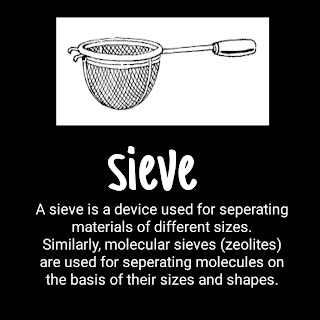Zeolites
- Zeolites are crystalline solid structures made of silicon, aluminium and oxygen that form a framework with cavities and channel inside where cations, water or small molecules may reside.

Examples of zeolites. - They are often also reffered to as molecular sieves.

Sieve and molecular sieve. - Many of them occur naturally as minerals and are extensively mined in many parts of the world finding application in industry and medicine. However, most of zeolites have been made synthetically.
- Zeolites are of two types
2) Synthetic zeolite.
- Natural zeolite: There are about 40 naturally occurring zeolites. Natural zeolite are non porous. For example; Natrolite.
- Synthetic zeolite: Synthetic (artificial) zeolites (around 150) have been designed for specific purposes. Synthetic zeolite are porous. Mordenite is a synthetic zeolite.
- Natural zeolites are used as animal feed, odour control, water purification and water treatment.
- Natural zeolites are also used as oil absorbent and catalyst.
- Synthetic zeolites are used as catalyst, detergents etc. Next
Comments
Post a Comment